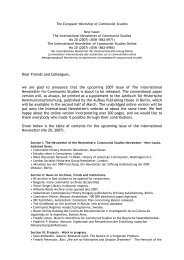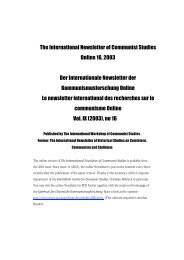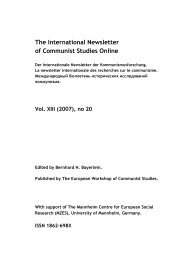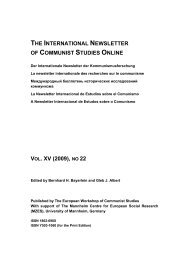VOL. XVI (2010), NO 23 - The International Newsletter of Communist ...
VOL. XVI (2010), NO 23 - The International Newsletter of Communist ...
VOL. XVI (2010), NO 23 - The International Newsletter of Communist ...
Erfolgreiche ePaper selbst erstellen
Machen Sie aus Ihren PDF Publikationen ein blätterbares Flipbook mit unserer einzigartigen Google optimierten e-Paper Software.
<strong>The</strong> <strong>International</strong> <strong>Newsletter</strong> <strong>of</strong> <strong>Communist</strong> Studies Online <strong>XVI</strong> (<strong>2010</strong>), no. <strong>23</strong> 161<br />
and, after being expelled from the UTW, helped to found the National Textile Workers’ Union<br />
<strong>of</strong> America, where she was elected first vice president.<br />
Between strikes, Dawson was active in the campaign to save Sacco and Vanzetti,<br />
<strong>International</strong> Women’s Day celebrations in New York City, and the communist workers<br />
movement <strong>of</strong> the period. She also traveled to Russia as part <strong>of</strong> a women’s delegation, and in<br />
1929 she was named to the executive committee <strong>of</strong> the <strong>Communist</strong> Party USA as a follower<br />
<strong>of</strong> Jay Lovestone. She was expelled from the party at the end <strong>of</strong> the year, as Joseph Stalin<br />
took control <strong>of</strong> the communist movement in the United States.<br />
Despite efforts to have her deported, she continued her radical activities into the early 1930s,<br />
serving as a key figure in Lovestone’s <strong>Communist</strong> Party <strong>of</strong> the U.S.A. (Majority Group), and<br />
writing for Revolutionary Age. <strong>The</strong>n, as the Great Depression engulfed America, she ended<br />
her career as an activist. She married, worked in the textile industry until retirement, dying in<br />
Florida in 1967.<br />
Strike! <strong>of</strong>fers a personal account <strong>of</strong> the Scottish Diaspora, especially the connection between<br />
Red Clydeside and the radical labor activists in the United States during the late 1920s; it<br />
demonstrates the difficulty associated with reconstructing the life <strong>of</strong> a working-class woman,<br />
especially a communist; and it examines the powerlessness <strong>of</strong> workers’ cause in a capitalist<br />
society.<br />
Comments by early reviewers <strong>of</strong> the book are extremely positive. Daniel Lee Georgianna<br />
(University <strong>of</strong> Massachusetts, Dartmouth) said, "Anyone interested in labor history or<br />
women's history will find this book <strong>of</strong> great use." Mary Anne Trasciatti (H<strong>of</strong>stra University)<br />
noted that the book "paints a vivid portrait <strong>of</strong> the people, places, and events that shaped<br />
Dawson and that she, in turn, shaped."<br />
Strike! will be available from the University Press <strong>of</strong> Florida in August <strong>2010</strong>. Additional<br />
information can be found at http://www.upf.com/book.asp?id=MCMUL001<br />
Xavier Botterman: Histoire du mouvement communiste à Verviers. 1919-1940.<br />
Avant-propos de Milou Rikir, Bruxelles, CARCOB, 2009. 193 p. (Travaux<br />
historiques. 3). ISBN 978-2-87188-009-7.<br />
L'intense développement de l'industrie de la laine a provoqué à Verviers la formation de deux<br />
classes aux intérêts contradictoires : la bourgeoisie patronale et le prolétariat ouvrier. Ce<br />
conflit a donné lieu à la naissance rapide d'un mouvement ouvrier marqué dès ses débuts<br />
par un fort courant révolutionnaire. Ainsi, Verviers sera longtemps un foyer anarchiste<br />
important. C'est dans ce contexte particulier que le Parti communiste s'installe dans la région<br />
verviétoise dès 1921. Il ne cessera d'être en continuel progrès durant tout l'Entre-deuxguerres.<br />
Les communistes représentent une fraction non négligeable de la gauche dans le<br />
centre industriel verviétois, dès 1925 au moins : 14 % de son électorat alors, puis un<br />
cinquième au début des années 1930, un tiers enfin en 1936. Sa force syndicale n'a pas<br />
d'équivalent dans d'autres coins de Wallonie. Faut-il pour autant en conclure que Verviers a<br />
été une ville « rouge » ? Pour répondre à cette question, l'auteur a autant considéré les<br />
spécificités de la région verviétoise que les décisions prises par la IIIe <strong>International</strong>e en<br />
fonction de l'évolution mondiale de la société. Son étude est présentée dans une triple<br />
perspective – internationale, nationale et locale – et suit les grandes étapes historiques ayant<br />
marqué le mouvement communiste à Verviers dans ses vingt premières années d'existence.














